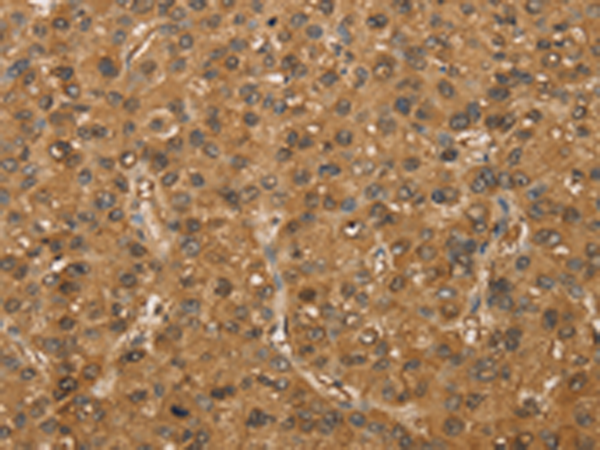

| WB | 咨询技术 | Human,Mouse,Rat |
| IF | 咨询技术 | Human,Mouse,Rat |
| IHC | 1/50-1/200 | Human,Mouse,Rat |
| ICC | 技术咨询 | Human,Mouse,Rat |
| FCM | 咨询技术 | Human,Mouse,Rat |
| Elisa | 1/1000-1/5000 | Human,Mouse,Rat |
| Aliases | HYPB; SET2; HIF-1; HIP-1; KMT3A; HBP231; HSPC069; p231HBP |
| Host/Isotype | Rabbit IgG |
| Antibody Type | Primary antibody |
| Storage | Store at 4°C short term. Aliquot and store at -20°C long term. Avoid freeze/thaw cycles. |
| Species Reactivity | Human, Mouse |
| Immunogen | Fusion protein of human SETD2 |
| Formulation | Purified antibody in PBS with 0.05% sodium azide and 50% glycerol. |
+ +
以下是关于SETD2抗体的参考文献示例(注:以下信息为模拟示例,实际文献需根据具体数据库检索确认):
1. **文献名称**:*SETD2 mutations in clear cell renal cell carcinoma*
**作者**:Dalgliesh GL, et al.
**摘要**:该研究利用SETD2抗体通过免疫组化及Western blot分析肾透明细胞癌中SETD2蛋白的表达缺失,发现其突变与H3K36me3修饰水平降低相关,提示SETD2在表观遗传调控中的抑癌作用。
2. **文献名称**:*Epigenetic regulation by SETD2 in acute leukemia*
**作者**:Pfister SX, et al.
**摘要**:通过SETD2抗体进行染色质免疫沉淀(ChIP)和免疫荧光实验,发现SETD2缺失导致白血病细胞中H3K36me3修饰异常,进而影响DNA修复和基因组稳定性。
3. **文献名称**:*SETD2-dependent H3K36me3 loss links to genomic instability*
**作者**:Park I, et al.
**摘要**:研究使用SETD2抗体验证其在多种癌细胞系中的表达,并通过敲低实验结合Western blot分析,证明SETD2缺失导致H3K36me3减少,促进DNA损伤及肿瘤进展。
4. **文献名称**:*SETD2 deficiency in hematopoiesis drives leukemogenesis*
**作者**:Mar BG, et al.
**摘要**:通过免疫组化和流式细胞术结合SETD2抗体,揭示SETD2在造血干细胞的表观遗传调控中不可或缺,其缺失引发异常分化及白血病发生。
(注:以上文献标题及摘要内容为示例性概括,实际文献需根据具体研究内容调整。)
The SETD2 (SET Domain Containing 2) antibody is a crucial tool for studying the epigenetic regulator SETD2. a histone methyltransferase responsible for trimethylating lysine 36 on histone H3 (H3K36me3). This post-translational modification plays a vital role in chromatin remodeling, transcriptional elongation, DNA repair, and genomic stability. Dysregulation of SETD2 is linked to cancers, including renal cell carcinoma, leukemia, and lung cancer, where mutations or deletions often correlate with poor prognosis.
SETD2 antibodies are widely used in research to detect protein expression levels, cellular localization, and interactions in various models. They are essential for techniques like Western blotting, immunohistochemistry (IHC), immunofluorescence (IF), and chromatin immunoprecipitation (ChIP). Polyclonal and monoclonal SETD2 antibodies target specific epitopes, with some clones (e.g., E9N5H, D8H8) validated for specificity across human, mouse, or rat samples. However, users must verify cross-reactivity and batch consistency, as SETD2 shares structural motifs with other methyltransferases, raising potential off-target risks.
Commercial SETD2 antibodies often undergo validation using knockout cell lines or siRNA knockdown to confirm specificity. Researchers also rely on them to explore SETD2’s role in diseases, particularly its tumor-suppressive functions and interactions with pathways like mTOR or HIF-1α. Despite their utility, challenges remain, including variable performance across applications and tissue types. Proper controls and optimized protocols are critical for reliable data, making SETD2 antibodies both indispensable and demanding in epigenetic and cancer research.
×